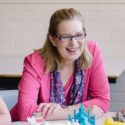We hear a lot of talk about what it’s going to take for our young people to thrive and survive in their 21st-century futures. It’s become almost cliched to talk about 21st-century skills but it is fair to say that many of today’s school students will be working in jobs that don’t yet exist and developing solutions for problems that we can’t yet predict.
It is crucial that students gain the skills and dispositions they will need to respond to uncertainty with resilience and optimism. Their school experiences need to equip them with tools to be able to identify problems and create solutions.
Design, technology and engineering curricula can play a key role in helping students develop these skills and dispositions.
It’s important to note that Design, Technology and Engineering are by no means new additions to subjects being taught in schools. However, curricula in these areas are changing to reflect the climate we are now living, working and learning in.
We’ve been monitoring what is happening with Design and Technology curricula around the world and we’ve noticed five big trends.
Design & Technology Trend 1: Focus on the Future
Reading through statements of aims and objectives, it is clear that Design and Technology curriculum is being intentionally crafted to help students to adopt futures mindsets. Students are being asked to design solutions that will have short and long-term impacts and to consider how their solutions will contribute towards preferred futures.
The Australian Curriculum includes the aim that students can investigate, generate and critique innovative and ethically designed solutions for sustainable futures, while the Next Generation Science Standards states that providing students with a foundation in engineering design allows them to better engage in and aspire to solve the major societal and environmental challenges they will face in the decades ahead.
Design & Technology Trend 2: Design Thinking
In the past, many design and technology curricula engaged students in a ‘design, make, appraise’ model to design products. This model is often applied as a linear series of steps that students follow. In short, the model tells students what to ‘do’.
Current and emerging curricula are shifting towards a focus on design thinking which engages students in a non-linear, human-centred and iterative design process. The process involves developing empathy and insights, defining problems, generating creative ideas, creating prototypes, testing and iterating designed solutions. This approach also tends to involve students working collaboratively and applying project management processes.
Thus, we are seeing a shift from doing to thinking.
Design & Technology Trend 3: Maker Pedagogy
Of course, curriculum documents can’t achieve anything without teachers. Teacher pedagogy is undoubtedly a key factor in how successfully students achieve the intended aims and objectives of any design and technology curriculum.
Maker-based pedagogies like maker spaces are increasingly being recognised as effective ways to achieve design and technology learning outcomes. These approaches position students as creators and inventors and recognise the value of making in learning.
Maker pedagogy is underpinned by Seymour Papert’s constructionist learning theory which says that learning is most effective when part of an activity the learner experiences as constructing a meaningful product.
Design & Technology Trend 4: Digital Building Materials
Learning experiences in design and technology often involve students analysing and selecting appropriate materials to use as they create solutions and build products.
In our technological age, new materials are constantly being developed. Seymour Papert’s work also encourages us to think of technology as a building material. Technology makes it possible to create and design in ways not accessible in the material world. While one may not be able to physically sculpt with any degree of accuracy, software programs make it possible to sculpt intricate figures in a virtual environment.
Design & Technology Trend 5: Starting Young
Around the world, design and technology is being included as a subject for our youngest learners. From the moment they start school, kindergarten children are working through design thinking processes, creating prototypes, making iterations and learning how to solve problems that matter to them.
How can Makers Empire help?
Makers Empire provides everything teachers need to help students achieve design, technology and engineering learning outcomes. Our intentionally designed 3D modelling tools and learning resources are the perfect tools for engaging K-8 students in exciting, challenging and curriculum focused learning.
New Makers Empire Design Curriculum
The new Makers Empire Design Curriculum describes the development of skills, knowledge and understandings across K-6, and helps teachers address design and technology, and engineering curricula from around the world including:
- The Australian Curriculum: Technologies, Design and Technologies
- Next Generation Science Standards (NGSS): Engineering Design (US)
- ISTE Standards for Students: Innovative Designer
- Common Core State Standards
- National Curriculum (UK)
- International Baccalaureate
- Victorian Curriculum
- The NSW Syllabus: Science K-10 (incorporating Science and Technology K-6)
The Makers Empire Design Curriculum has six content strands:
- Technology Application
- Investigating
- Generating Ideas
- Prototyping and Modelling
- Testing and Evaluating
- Planning and Managing
The challenges in the Makers Empire 3D modelling app are directly aligned with our new design curriculum. As students work their way through design problems, challenges and fun activities, teachers can download reports about how each student’s achievements address the applicable curriculum in their state or country.
Together with Makers Empire, teachers can unleash the potential of design and technology curricula and make sure our students are ready to take on the world.
AUTHOR BIOGRAPHY



2 Responses